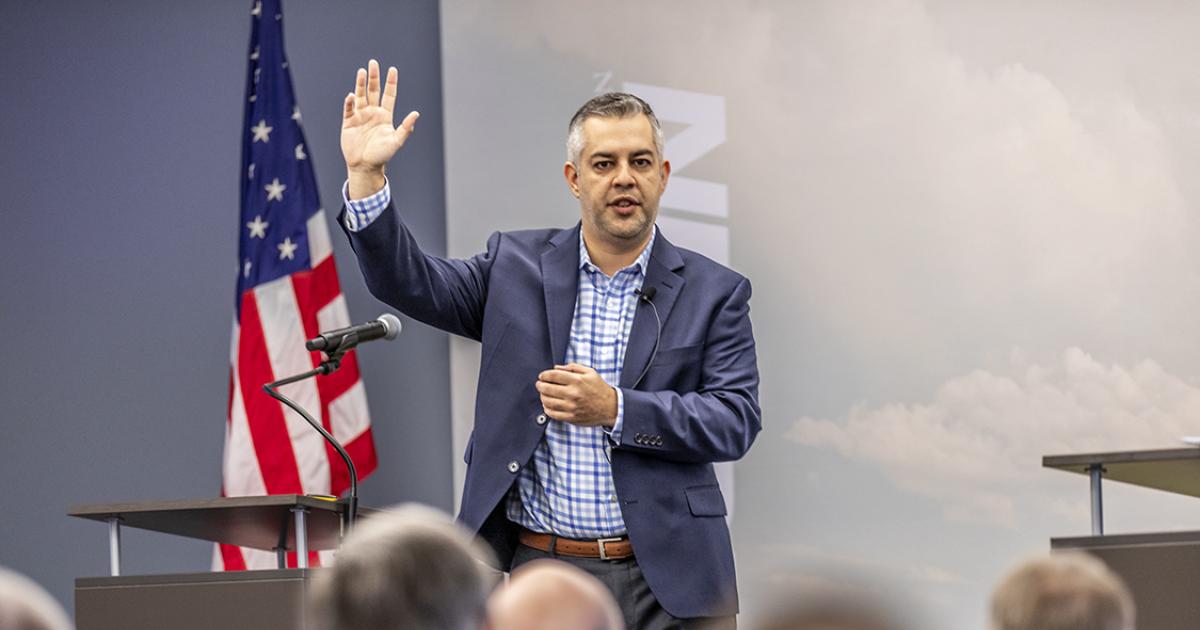John Moura, North American Reliability Corporation director of reliability assessment and system analysis, speaks to a room of North Dakota co-op leaders Feb. 13 in Mandan. Photo by NDAREC/Liza Kessel
The electric industry is in a state of transition. In the mid-2000s, a shift away from fossil-fuel generation toward renewables began taking shape. The green energy conversation has dominated the industry for several decades. Consumers have more interest in where and how their power is produced. Policy, regulation and private investment capital continue to step on the accelerator toward a lower carbon future.
But, another critical conversation has emerged in recent years – it’s message ringing louder and louder as extreme weather events test the nation’s electric grid.
Reliability. It’s the ability to meet electric demand – to provide the electricity you need, when you need it – 24 hours a day, 7 days a week, 365 days a year.
And, it’s at risk.
The North American Reliability Corporation (NERC), which is a not-for-profit international regulatory authority whose mission is to assure the effective and efficient reduction of risks to the reliability and security of the electric grid, has warned electric reliability is in jeopardy and the risk of rolling blackouts is rising. It recently listed energy policy as a newfound reliability risk. And, it says the “disorderly” retirements of existing electric generation assets – primarily coal plants – are directly impacting reliability. Generation assets taken offline in recent years have been replaced with sources providing less capacity, no capacity or intermittent capacity not available 24/7.
All while electric demand continues to soar. NERC estimates the demand for electricity will grow 10% through 2032, while the electric generation to meet that demand is projected to grow only 4% in that time.
“Electricity is, kind of, the new form to power the future. And I think everybody is excited about that. We just have to do it reliably,” says John Moura, NERC’s director of reliability assessment and system analysis.
“We can pick and choose what types of resources we have on the system, but we’ve got to have that conversation about reliability first, which I think is why a lot of the conversation has been oriented toward reliability, because we don’t have a common understanding of what that is,” he says. “And a lot of people are just starting to learn about how the system works, how long it takes to actually build infrastructure and all the different decisionmakers it takes to get on board with that future.”
FUELING THE FUTURE
The U.S. Energy Information Administration predicts the combined electricity generation from wind (459.3 billion kilowatt-hours or kWh) and solar (228.3 billion kWh) will surpass coal-fired generation (688 billion kWh) in the United States in 2024 for the first time on record, according to its December 2023 “Short-Term Energy Outlook.”
On the positive side, the electric industry has made tremendous progress meeting environmental goals and commitments.
But, reliability has been sacrificed. More solar and wind and less coal on the system means the U.S. electric grid is becoming more reliant on less reliable forms of energy.
“If we can’t integrate those renewables reliably, they’re not going to help,” Moura says.
“We have less capacity on the system than we ever have in the past, because we’ve retired a lot of fossil-fuel generation,” he says. (Grid capacity refers to how much power the electric system can safely and reliably deliver. It is an aggregation of all the generation resources available.)

Dispatchable resources, like coal, are being replaced by non-dispatchable resources, like wind and solar, and at a record pace.
A dispatchable resource is a highly reliable power source that offers a constant fuel supply. It can be ramped up or ramped down to meet demand, and it is available in all weather conditions. Examples include coal, natural gas and nuclear.
A non-dispatchable resource is a less reliable electric power source that provides an intermittent, not-always-available, but environmentally beneficial, fuel supply. Examples include renewables like wind, solar and hydro, which fail to produce power in some weather conditions, such as when the wind doesn’t blow or the sun doesn’t shine.
Moura says 110 gigawatts of coal resources – which provide enough electricity to power 82.5 million homes – are planned to retire, and others are in the works, though not transparently disclosed.
“I worry about the future of coal going to zero,” Moura says. “We need to manage the pace of retirements (of coal assets).”
And it’s not because one fuel source is better than another, the “fuel-agnostic” Moura says. It’s because a diverse resource portfolio is the key to a reliable energy future.
“Those complementary resources, I think, are really what the future looks like,” he says. “Having sets of dispatchable resources that can be called upon, but also making sure we’re delivering renewable, clean energy with solar and wind.”
To meet U.S. electric demand now and in the future, it will require an all-of-the-above energy approach. Dispatchable and non-dispatchable resources. Renewables. Fossil fuels. All of it. It will also require moving past the which-fuel-is-better debate to a conversation about reliability.
“Those conversations about fuel are absolutely needed,” Moura says. “The thing about energy, it takes a whole ecosystem to make decisions about it. We have to balance economics and affordability, environmental steward(ship) and reliability. And so, all those conversations are really needed, and really healthy… which fuels might work for certain areas, other fuels and profiles that might work for other areas, but the base of that equation is reliability.”
 THE ROLE OF ELECTRIC COOPERATIVES
THE ROLE OF ELECTRIC COOPERATIVES
Moura and NERC aren’t the only ones elevating the reliability message. Across the country, electric cooperatives have been reliability champions.
As not-for-profit, member-owned electric service providers, their mission continues to be providing reliable, affordable electricity to their members.
“Electric cooperatives play a vital role in the future of the bulk power system and reliability. And their commitment to reliability is unmatched. They are member-owned systems, and so they very much care about reliability,” Moura says. “And I work with a lot of cooperatives, and I’ll tell you, they have a tremendous commitment to reliability and they’re always willing to help educate others.”
But a secure, reliable energy future won’t – and can’t – be accomplished by electric cooperatives alone.
“We (at NERC) have a number of recommendations around what’s needed to maintain reliability. And when we look at the challenges, all the players that are involved – whether it be the states, at the federal level, at the community level, counties and municipals – all of the entities are needed to come together and make sure we’ve got a reliable system,” Moura says. “We have extraordinary challenges, and it’s going to require some extraordinary actions from each one of them.”
___
Cally Peterson is editor of North Dakota Living. She can be reached at cpeterson@ndarec.com.










